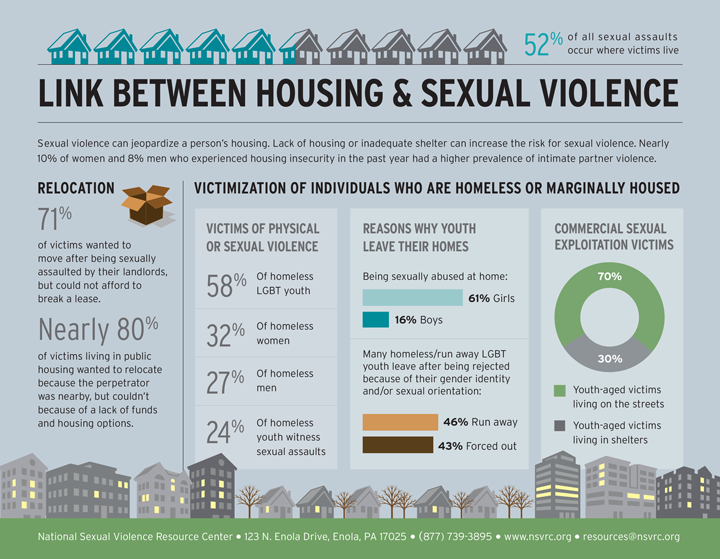The relationship between homelessness and sexual violence is more complicated than it appears at first glance. The infographic below, published by the National Sexual Violence Resource Center of the United States, illustrates the strong link that exists between housing and sexual violence.
The infographic shows that in the United States, sexual abuse at home is a cause of homelessness for 61% of homeless girls and 16% of homeless boys. Women face many additional risks compared to men in critical housing situations, especially when it comes to issues of violence. Being female and young further increases the risk of sexual violence.
Revealing one’s sexual identity can lead to rejection and stigma at home. Such persecution has resulted in 43% of LGBTQ2 youth being forced out of their homes and 46% choosing to leave their homes for the streets. While these individuals face the difficulties that other homeless youth face, they face the additional stressor of identifying themselves as being LGBTQ2. Despite the knowledge that LGBTQ2 youth are disproportionately represented among the homeless population (likely two times greater compared to other age groups), there is minimal research that has been conducted on the needs of this population. Existing supports for this group are few, and there are currently zero specialized housing initiatives directed at LGBTQ2 homeless youth in Canada.
The infographic also recognizes the need for choice when it comes to housing options. Sometimes, available housing is located near the perpetrator of a past sexual assault or an abusive relationship exists between the landlord and tenant. Many victims of sexual violence living in public housing would relocate, if provided the option. Tenants who are the subject of abuse by their landlords may be unable to move out because 1) there are no other housing options available or 2) other available housing options are unaffordable. Location matters, and in circumstances resembling those described above, a lack of housing options can be the cause for increased psychological stress and fear and can even be precursor to future violence.
An understanding of sexual violence as both a cause of homelessness and a symptom of homelessness informs existing services and demonstrates the need for new programs. Programs can be developed to take the individual histories of those experiencing homelessness into account. Examples include services that address the needs of victims of sexual assault, creating programs aimed directly at homeless LGBTQ2 youth and having solutions in place that provide individuals with tailored housing options.


